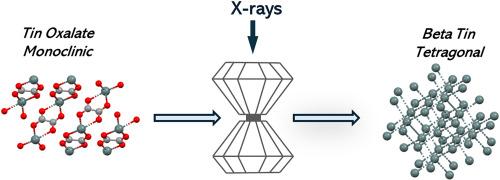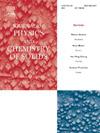X 射线诱导合成β锡(β-Sn)
IF 4.3
3区 材料科学
Q2 CHEMISTRY, MULTIDISCIPLINARY
引用次数: 0
摘要
以前曾利用硬 X 射线破坏分子结构的稳定性来合成新型化合物。在这里,我们报告了在环境压力和 0.6 GPa 压力下,单色 X 射线诱导草酸锡(II)(SnC2O4)分解导致形成β锡(β-Sn)。在 1 GPa 的压力下,只观察到 SnC2O4 晶体结构的退化,而在辐照结束时没有任何 β-Sn 的迹象。在 0.6 GPa 时实现了最大转化率,这表明分子间距离在 X 射线诱导合成 β-Sn 的过程中起着关键作用。此外,还利用修正的阿夫拉米方程描述了在环境和 0.6 GPa 下结构合成的动力学和几何形状。研究结果表明,X 射线辐照可诱导不同于传统方法(如高压、温度、化学计量混合)的光化学合成途径,高压(HP)可被视为控制 X 射线诱导光化学的工具。本文章由计算机程序翻译,如有差异,请以英文原文为准。

X-ray induced synthesis of beta tin (β-Sn)
The destabilization of molecular structures via hard X-rays has been previously utilized to synthesize novel compounds. Here we report that the monochromatic X-ray induced decomposition of tin(II) oxalate (SnC2O4) at ambient and 0.6 GPa pressures lead to the formation of beta tin (β-Sn). At 1 GPa, only the degradation of SnC2O4 crystal structure is observed without any indication of β-Sn at the end of irradiation. The maximum transformation yield is achieved at 0.6 GPa suggesting the critical role of intermolecular distance in X-ray induced synthesis of β-Sn. Moreover, a modified Avrami equation is utilized to describe the kinetics and geometry of structural synthesis at ambient and 0.6 GPa. The obtained results demonstrate that X-ray irradiation can induce photochemical synthetic pathways different from conventional methods (e.g., high pressure, temperature, stoichiometric mixing) and that high pressure (HP) can be considered a tool to control X-ray induced photochemistry.
求助全文
通过发布文献求助,成功后即可免费获取论文全文。
去求助
来源期刊
CiteScore
7.80
自引率
2.50%
发文量
605
审稿时长
40 days
期刊介绍:
The Journal of Physics and Chemistry of Solids is a well-established international medium for publication of archival research in condensed matter and materials sciences. Areas of interest broadly include experimental and theoretical research on electronic, magnetic, spectroscopic and structural properties as well as the statistical mechanics and thermodynamics of materials. The focus is on gaining physical and chemical insight into the properties and potential applications of condensed matter systems.
Within the broad scope of the journal, beyond regular contributions, the editors have identified submissions in the following areas of physics and chemistry of solids to be of special current interest to the journal:
Low-dimensional systems
Exotic states of quantum electron matter including topological phases
Energy conversion and storage
Interfaces, nanoparticles and catalysts.

 求助内容:
求助内容: 应助结果提醒方式:
应助结果提醒方式:


